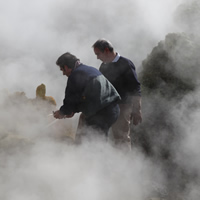Modelling the effects on the hydrothermal system of Campi Flegrei of magma degassing close to the critical pressure
| Lunedì 3 Aprile | ore 11.30 | Giovanni Chiodini – INGV OV | Sala seminari – INGV Sezione di Pisa
Abstract
An ascending magma batch, upon decompression, selectively releases dissolved volatiles depending on their solubilities so that, while barely soluble CO2 dominates “deep” degassing, more soluble H2O prevails at shallow depths. This selective release of volatiles from magma implies that heat transfer to overlying hydrothermal systems exhibit a non-linear pressure dependence. By applying a gas-melt degassing model, we find that there is a narrow pressure interval (CDP, critical degassing pressure) over which the total amount of separated fluid and of the associate thermal energy steeply increases by more than one order of magnitude. Evidence of critical degassing, and consequent heating of the hydrothermal system, are clear at Campi Flegrei caldera. Large variations in the N2-He-CO2-Ar fumarole compositions, indicative of degassing in open-system conditions at increasingly lower pressures, are in fact accompanied by a 15 years long exponential increase of the fumaroles’ CO indicating a generalized heating up of the hydrothermal system. Based on these observations Campi Flegrei magmatic system may be approaching the CDP, i.e. a depressurising magma batch is releasing fluids of progressively more H2O-rich (and CO2-poor) compositions, perturbing the thermal structure of the hydrothermal system. This hypothesis was tested by comparing the observed geochemical and geophysical sinals with the results of TOUGH2 models of a hydrothermal system affected by the input of magmatic fluids, which increase their H2O/CO2 ratio during time. Ground deformation, background seismicity and gas geo-indicators proceed following surprisingly well the simulated time pattern of temperature increase of the hydrothermal system. We conclude, that since 2005 magma degassing approaching CDP and heating of the system are controlling both background seismicity and the deformation at Campi Flegrei caldera.


